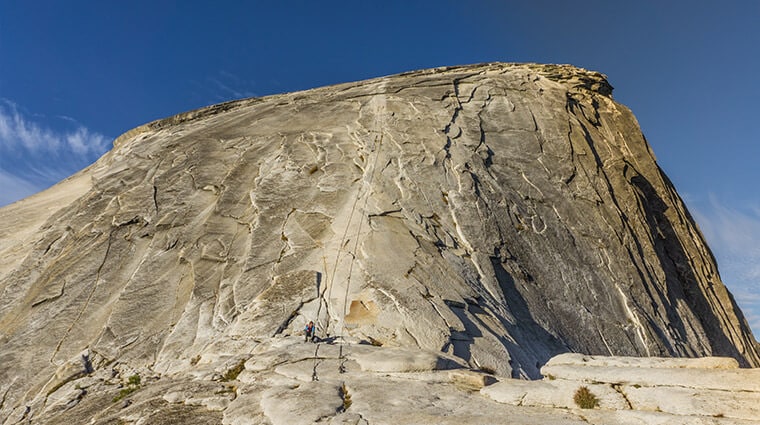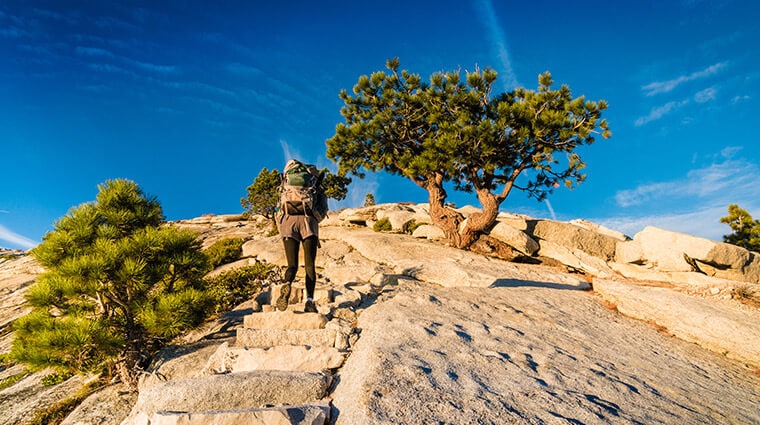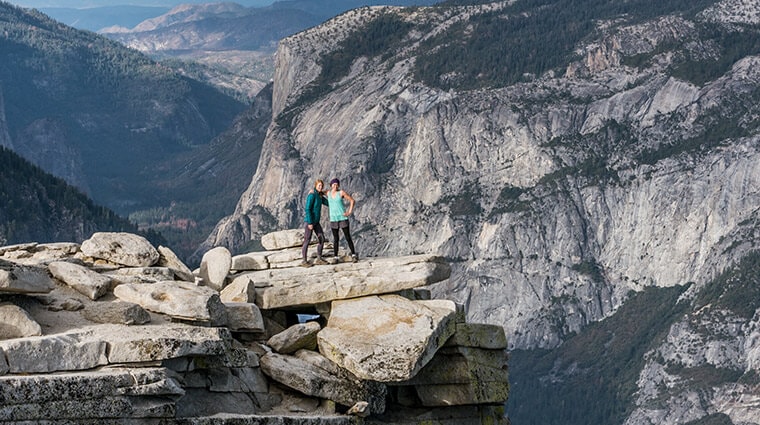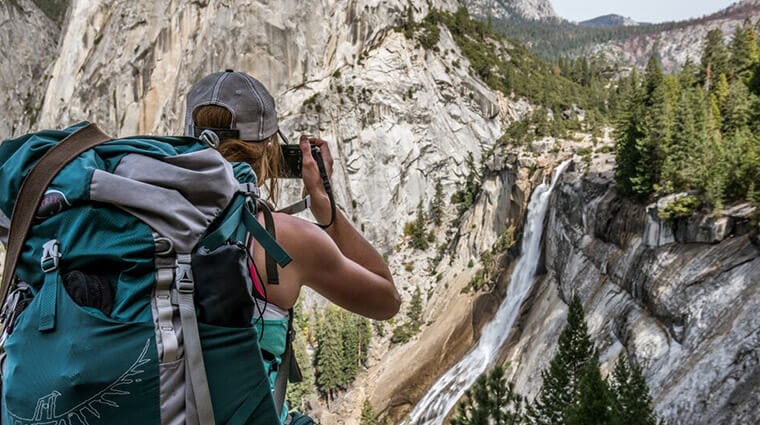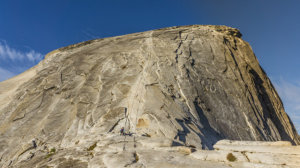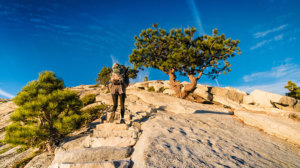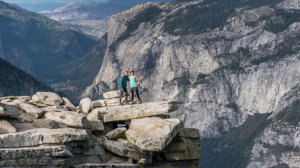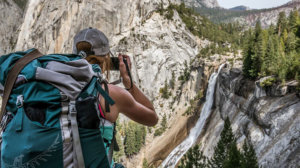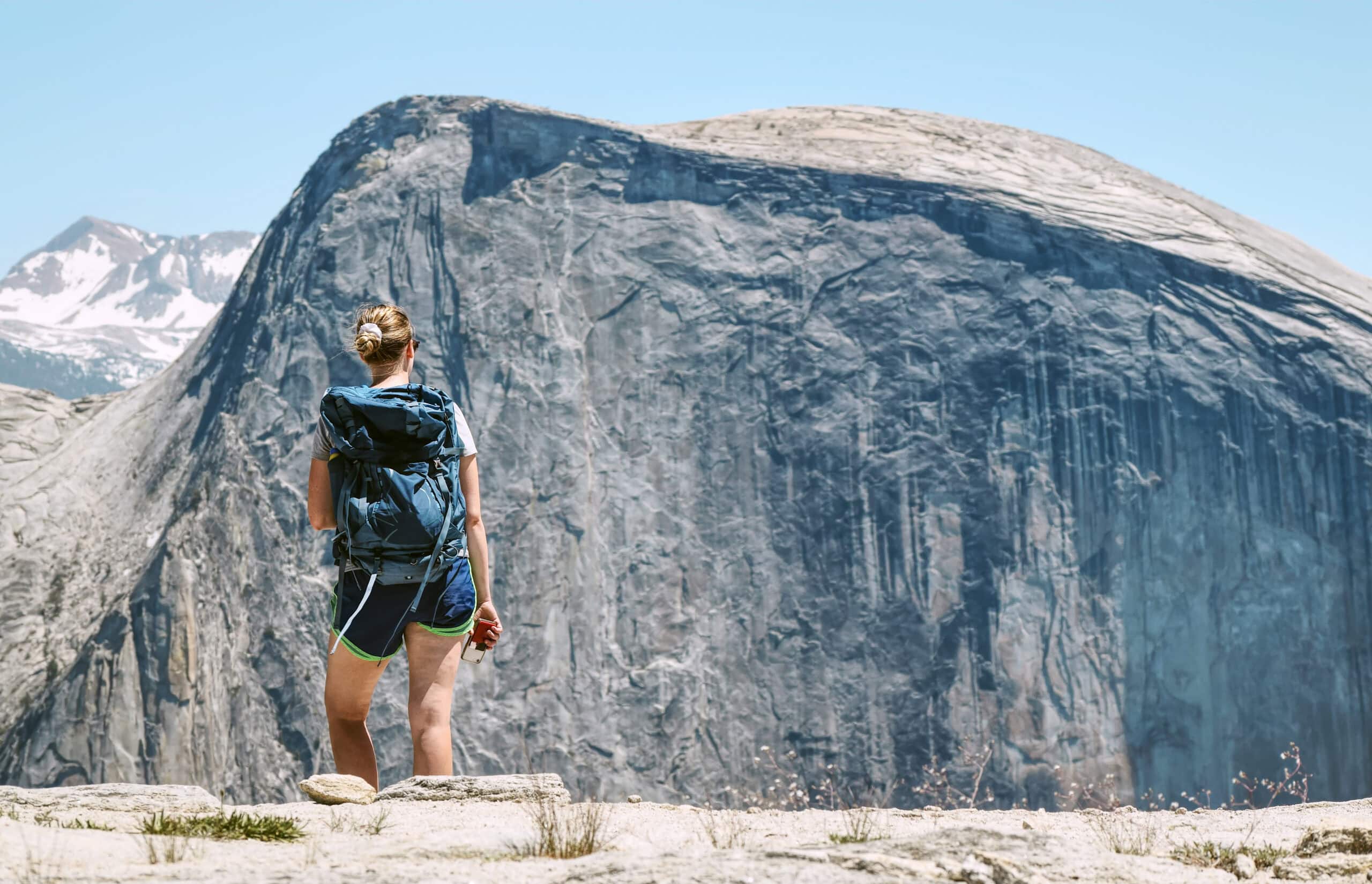
Half Dome Hike
Half Dome Hike
Yosemite Valley
Half Dome, Mariposa County, CA, United States
Overview
Distance: 14-17 miles (22-27 km)
Elevation gain: 4,800 ft (1463 m)
Difficulty: Strenuous
Time: 12-16 hours (out and back)
Begin at: Happy Isles Trailhead Yosemite Valley
Yosemite’s Half Dome hike combines its most iconic attraction and most prestigious hike.
Half Dome’s uniquely identifiable face stands proudly over the eastern end of Yosemite Valley. The trail to Half Dome from Yosemite Valley is an extremely steep and strenuous hike covering over 14-16 miles. Hikers gain 4,800 feet of elevation along the trail that passes highlights such as Vernal Fall and Nevada Fall, before reaching the cables on Half Dome’s steep granite domes. Steel cable handrails and wooden planks are set up along the dome to assist hikers to the summit in the summer months. The cables are removed every October, and replaced in late May.
Hiking Half Dome
Preparation is important for a hike of this magnitude. Understand your limits, take enough water, and plan appropriately. Several Half Dome hikers are rescued each year due to unpreparedness, and the most common first aid response issues are related to dehydration. If you have one, it is also a good idea to take a filtration water bottle or iodine tablets in case you need to replenish your water along the trail.
Can a Beginner Hike Half Dome?
Hiking to the summit of Half Dome is a long and strenuous hike, so not ideal for beginners without much hiking experience. If you’re just starting out hiking, consider trying some of the easier trails on this list before tackling the Half Dome hike.
Parking & Trailhead Information
Most hikers kick off their journey from Happy Isles (shuttle stop #16), conveniently located approximately half a mile from the trailhead parking lot or just under three-quarters of a mile from Curry Village. The trailhead parking lot is situated just beyond Curry Village.
For early birds arriving before the 7:00 AM shuttle service begins, plan to walk the trail next to the road from either of the parking areas to reach the trailhead.
Closest Place to Stay for Hiking Half Dome
Since most people will be preparing for a long hiking day, getting a place to stay that is close to the trailhead can help you get an extra early start. The closest lodging to the Half Dome trailhead is Curry Village where you can get a comfortable night’s sleep in a tent cabin, hard-sided cabin or hotel room. Lodging at the Yosemite Valley Lodge or The Ahwahnee in Yosemite Valley also lets you wake up within minutes of the trailhead. The closest campgrounds are Upper, Lower, and North Pines Campgrounds, but securing reservations during the summer can be quite challenging.
Another possibility is Camp 4, which may require reservations depending on the season, or operate on a first-come, first-served basis.
Beyond Yosemite Valley, consider vacation rental cabins in Foresta or Yosemite West, or a variety of options outside the park gates in El Portal.
Recommended Gear
Yosemite’s backcountry trek demands appropriate hiking gear for a safe and enjoyable experience. If you lack specialized hiking equipment, opt for comfortable athletic attire and sturdy, slip-resistant footwear. Ensure your backpack contains the following essentials:
- 3-4 liters of water (or less if equipped with a water filter for refills in Little Yosemite Valley).
- An assortment of energy bars or snacks for sustenance.
- Carry a headlamp or flashlight in case your adventure extends past sunset.
- Include an extra layer of clothing and a lightweight shell for changing weather conditions.
- Don’t forget a trowel and toilet paper for emergencies, as there are no restroom facilities beyond Little Yosemite Valley.
- If you’re already familiar with them, consider bringing your trekking poles for added support.
Half Dome Cables
The highlight, or perhaps the most challenging part of this hike, lies in climbing the cables. These dual metal cables provide a lifeline for hikers, enabling them to conquer the last 400 feet of elevation without requiring specialized rock climbing gear. Notably, since 1919, fatalities on the cables have been relatively rare, but injuries are possible, especially among those who take unnecessary risks.
Regarding the cables’ operation schedule, they are typically put in place on the Friday preceding Memorial Day (the last Monday in May) and taken down after the second Monday in October. Please be aware that these dates may change depending on the prevailing conditions.
It’s essential to keep the following in mind when tackling the cables: exercise patience and accommodate slower hikers. Yield to faster climbers when possible, and stay positioned on the inside of the cables. Also, avoid attempting the ascent during stormy weather. Being on the summit of Half Dome during a thunderstorm puts you at risk of being struck by lightning, and wet conditions make both the cables and the rock surface exceedingly slippery. Always check for current conditions and updates regarding cable status before embarking on this adventure.
Safety
As per Yosemite National Park’s guidance, it’s crucial to be mindful of the common challenges that Half Dome hikers face:
- Sprained ankles and twisted knees: Particularly on the Mist Trail section, hikers should exercise caution to avoid spraining ankles or twisting knees.
- Dehydration and exhaustion: Dehydration can quickly lead to exhaustion on this demanding hike. Ensure you stay adequately hydrated throughout your journey.
- Slips and falls: Overexertion and pushing beyond one’s limits can result in slips and falls. It’s essential to pace yourself and prioritize safety.
- Hiking after dark without illumination: Getting caught out after dark without proper illumination can be risky. Plan your hike to avoid being in this situation.
Taking the time to prepare, train, and gather information about the trail can significantly enhance your experience and turn it into a memorable adventure rather than a challenging one.
Half Dome Hike Permits
A Half Dome hike permit is required seven days per week while the cables are installed. This protects the wilderness character of the trail, reduces crowding, and increases safety. Prior to the permit system, hikers sometimes lined up to wait an hour or more in the hot sun just to get on the cables.
Day hikers can now enter a lottery to win some of the 300 permits available for Half Dome each day. There is a preseason lottery from March 1 – 31 (Eastern time). If you apply for the preseason lottery you will be notified about the results in mid-April. For those of us who prefer a more spontaneous trip, there is also a daily lottery. Enter the lottery two days before your intended hiking date, and get a notification late that evening about the results. So, if you wanted to hike on a Saturday, you would apply on Thursday, and know by Thursday night whether you should pack and prepare for your trip.
Day hike permits are exclusively available through online reservations at www.recreation.gov or by contacting (877)444-6777. You can Not get walk-up Half Dome permits at the Visitor’s Center.
Reservations for the permits can be made online at www.recreation.gov or by calling (877) 444-6777.
To learn more about the Half Dome hike please visit
www.nps.gov/yose/planyourvisit/halfdome.htm
Ways to Hike Half Dome
As you might expect, there are several routes to hike to Half Dome. The most popular and iconic route is the one that starts from Yosemite Valley. However, there are alternative approaches to reach Half Dome:
- Mist Trail Route: This is the most well-known route. It starts at the Happy Isles Trailhead and includes hiking past Vernal Fall and Nevada Fall, close enough to feel the waterfalls’ mist on your face before reaching the Half Dome cables.
- John Muir Trail (JMT): Another option from Yosemite Valley involves taking the John Muir Trail. This trail is longer, but avoids the steep stairs on the Mist Trail, and then rejoins the main route to Half Dome near Nevada Fall. You also pass Vernal and Nevada Fall, but the viewpoints are from further away.
- Glacier Point Route: You can begin your hike at Glacier Point, which offers breathtaking views of Yosemite Valley. The trail from Glacier Point to Half Dome is the Panorama Trail, and it joins the Mist Trail near Nevada Fall. Note that if you choose this alternative, you will have a long climb out of Illilouette Canyon at the end of your hike.
- Sunrise Lake Trailhead: A less crowded option starts at the Sunrise Lakes Trailhead, near the western edge of Tenaya Lake along Tioga Road. This alternative gives you the option of summiting Cloud’s Rest as well as Half Dome, but you can also go around Cloud’s Rest if you want to. It offers a high country experience and connects with the main trail near the subdome.
The most popular day-hike route starts at the Happy Isles shuttle stop in Yosemite Valley and climbs the Mist Trail. On the return journey, many people choose to descend via the John Muir Trail (JMT) instead of the Mist Trail. The JMT is slightly longer than the Mist Trail but offers some fresh views and a more gradual descent that is easier on the knees. After such a long hike, navigating the wet steep steps of the Mist Trail can be quite challenging.
Other Yosemite National Park HIkes Similar to Half Dome
Yosemite National Park offers a wide range of hiking opportunities, catering to hikers of various skill levels and preferences. Here are some popular hikes and trails within Yosemite that are similar to Half Dome:
Vernal or Nevada Fall
The hikes to Vernal Fall and Nevada Fall are on the way to Half Dome, but you don’t need to go all the way to the top to enjoy these popular and moderately strenuous hikes to some of Yosemite’s most famous waterfalls.
Mirror Lake/Meadow Trail
For fantastic views of Half Dome from the bottom rather than the top, check out the Mirror Lake/Meadow trail. This easy, mostly flat hike is approximately a 2-mile round-trip and offers a peaceful escape with picturesque views of the lake (in spring) or meadow (in late summer/early fall) with Half Dome towering above.
Sentinel Dome Hike
Sitting just opposite Half Dome, Sentinel Dome is Half Dome’s baby cousin. For those looking for that high-up view of Yosemite’s grand landscapes, you could trade the long hike for a 2-mile jaunt, but keep the magnificent 360 view from the summit – the mesmerizing view of Half Dome from the summit of Sentinel Dome is an extra bonus!
Cloud’s Rest
Located just northwest of Half Dome, Cloud’s Rest is one of Yosemite’s less famous, but equally spectacular summits, and appeals to those looking for a challenging hiking day. The most easy approach is from the Tioga Road, starting from the Sunrise Lakes trailhead. This route is still long, 14.5 miles (23.3 km) round-trip, and includes 1,775 ft (540 m) of elevation gain, and instead of the infamous cables, you’ll walk a very narrow mountain ridge with incredible exposure on both sides. (For a really big day, you can also hike to Cloud’s Rest from Yosemite Valley, bypassing Half Dome for it’s taller neighbor.)
FAQ
How long does it take to hike the Half Dome?
The duration it takes to hike Half Dome can vary significantly depending on several factors, including your starting point, hiking experience, fitness level, and weather conditions. A general guideline is to plan for approximately 12-16 hours.
How hard is the Half Dome hike?
The Half Dome hike is considered to be a strenuous and challenging hike. Hikers should be in good physical condition, have appropriate gear, carry enough water and supplies, and be aware of their own limitations. It’s also crucial to check trail conditions and obtain the necessary permits before attempting the hike.
Which is harder – Half Dome or Angels Landing?
Hiking to the top of Angel’s Landing in Zion National Park is wild and airy and fun, and compared to hiking Half Dome, it’s a walk in the park.
Hiking to the top of Half Dome is roughly 3 times as far as the distance to hike Angel’s Landing, and instead of gaining 1,827 feet (557 m) for Angel’s Landing, you need to be prepared to gain 4,800 feet (1463 m). From a psychological perspective, the last 500 feet (152 m) to the top of Angel’s Landing can be intimidating. Climbing 400 feet (122 m), Half Dome’s cables are nearly as long, also vertiginous, and you’ll be doing it after a longer approach.
Half Dome Trail Map
Looking for Half Dome trail maps to prep you for your hike?
